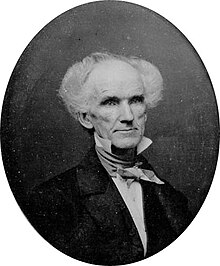James Barton Longacre
| James B. Longacre | |
|---|---|
 |
|
| 4th Chief Engraver of the United States Mint | |
|
In office September 16, 1844 – January 1, 1869 |
|
| President | |
| Mint Director |
|
| Preceded by | Christian Gobrecht |
| Succeeded by | William Barber |
| Personal details | |
| Born |
James Barton Longacre August 11, 1794 Delaware County, Pennsylvania, United States |
| Died | January 1, 1869 (aged 74) Philadelphia, Pennsylvania, United States |
| Resting place | Woodlands Cemetery, Philadelphia, Pennsylvania |
| Nationality | American |
| Spouse(s) | Elizabeth Stiles (married 1827, died 1850) |
| Children |
|
| Occupation | Portraitist, engraver |
James Barton Longacre (August 11, 1794 – January 1, 1869) was an American portraitist and engraver, and from 1844 until his death the fourth Chief Engraver of the United States Mint. Longacre is best known for designing the Indian Head cent, which entered commerce in 1859, and for the designs of the Shield nickel, Flying Eagle cent and other coins of the mid-19th century.
Longacre was born in Delaware County, Pennsylvania in 1794. He ran away to Philadelphia at age 12, becoming an apprentice in a bookstore. His artistic talent developed and he was released to apprentice in an engraving firm. He struck out on his own in 1819, making a name providing illustrations for popular biographical books. He portrayed the leading men of his day; support from some of them, such as South Carolina Senator John C. Calhoun, led to his appointment as chief engraver after the death of Christian Gobrecht in 1844.
In Longacre's first years as a chief engraver, the Philadelphia Mint was dominated by Mint Director Robert M. Patterson and Chief Coiner Franklin Peale. Conflict between Longacre and the two men developed after Congress ordered a new gold dollar and double eagle, with both to be designed by Longacre. Peale and Patterson nearly had Longacre fired, but the chief engraver was able to convince Treasury Secretary William M. Meredith that he should be retained. Both Patterson and Peale left the Mint in the early 1850s, ending the conflict.
In 1856, Longacre designed the Flying Eagle cent. When that design proved difficult to strike, Longacre was responsible for the replacement, the Indian Head cent, issued beginning in 1859. Other coins designed by Longacre include the silver and nickel three-cent pieces, the Shield nickel, and the two-cent piece. In 1866–1867, he redesigned the coins of Chile. Longacre died suddenly on New Year's Day 1869; he was succeeded by William Barber. Longacre's coins are generally well-regarded today, although they have been criticized for lack of artistic advancement.
...
Wikipedia
